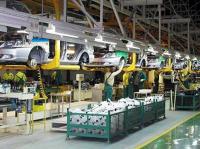 |
Home page / News & Analysis
/ Latest news
/ Chinese Cars Delivered Losses Worth Millions To Russians
|
|
|
Chinese Cars Delivered Losses Worth Millions To Russians
26.11.2009 — Analysis Against the backdrop of an increasingly close and fruitful cooperation between Russia and China, business projects for assembling Chinese cars within Russia stand somewhat apart. The RusBusinessNews correspondent has found out that at least two attempts have been made to establish such production in the Urals Federal District, and that both projects have come tumbling down. In 2006 in Zlatoust (the Chelyabinsk Oblast) the Urals Automotive Company was established in order to manufacture and sell Shuttle off-road vehicles out of Chinese-made components. To accommodate the assembly site, a former SLBM workshop at the Zlatoust Machinery Plant was redesigned. Alexander Karlov, Advisor to the President of the "Gorny Ural" (Russian for ‘Mountain Urals') Chelyabinsk Oblast Municipalities Association, told RusBusinessNews that the Russian replica of the Chinese Dadi Shuttle was intended to compete with the Russian UAZ Patriot in terms of comfort and quality, and with Japanese and Korean offroad vehicles in terms of price. Urals-assembled Shuttle was different from its Celestial Empire-based prototype for a more spacious and better heated interior adjusted to the Russian driver's "dimensions", improved pedal assembly, and an engine that has been adapted to Russian petrol. It was planned for all components to be made in the PRC, although licensed by global automotive brands. The project got stuck and, as early as 2007, the Urals Automotive Company has completely discontinued the manufacturing of the Shuttle, switching from offroad vehicles to Geely passenger cars within a joint project with CJSC Automobiles and Motors of the Urals (AMUR). Two years ago in Novouralsk, the Sverdlovsk Oblast, AMUR has commenced a joint project with Zhejiang Geely Holding Group Co. Ltd from Shanghai for the manufacturing of Geely CK-1 passenger cars. According to Yuri Afanasyev, the Director General of CJSC AMUR, there were enough components imported from China to make over 4 thousand cars. The plant was expected to work two shifts producing at least 25 thousand cars a year. Then the annual production volume was supposed to reach 100 thousand cars. However, these plans were not destined to come true. The Urals Automotive Company that has become an affiliate of CJSC AMUR paid about 1 million U.S. dollars in advance to Geely International Co. Ltd for the shipment of components. However, in the autumn of 2008 the Russian Government has raised customs duties for the import of painted car bodies by 15% rendering the manufacturing in Novouralsk unprofitable. Geely has not shipped the components and tied up the money in its accounts. Khalim Bilalov, the Director General of Avtodroog LLC, Moscow, told RusBusinessNews that his company had found itself in exactly the same situation as the AMUR-UAC alliance: Geely has still not returned 1 million U.S. dollars to Avtodroog, nor has it shipped the cars which had been ordered. He also noted that not a single complaint submitted by the Russian company regarding the quality of Chinese cars has been rectified. According to Ekaterina Khaimenkova, PR Director of AMUR, letters from the Russian Chamber of Commerce and Industry and the Sverdlovsk Oblast Ministry of Industry with an application for the return of the money have been sent to the Consulate General of the PRC in Ekaterinburg and the Russian Trade Mission in the PRC; however, the money "truck" has still not got into gear. All in all, Alexander Karlov sees the conditions for Russian-Chinese automotive projects to be successful if the four key prerequisites are met: first, their profitability can only be achieved in case of achieving a certain capacity of the production. The break-even point is only fixed at reaching the manufacturing quantities of about 50 thousand cars a year. Secondly, the production of some components must be located in Russia so as to avoid customs costs; thirdly, the attention must be focused mostly on the quality of the components - the aspect where the Chinese still are lagging behind, to put it mildly; and fourthly, arrangements for shipping Chinese components into Russia must be direct, excluding middlemen whose mark-ups substantially raise the cars production costs. Notwithstanding the failed projects, the Urals machine builders are not inclined to give up the idea of cooperation with the Chinese automotive sector completely. According to Khalim Bilalov, Avtodroog is prepared to work with Chinese on condition they achieve a certain quality level of their cars and act honourably in financial issues. Ekaterina Khaimenkova pointed out that the Chinese business people's interest to establishing joint projects in Russia will remain, first of all in the production of trucks and lorries. AMUR is negotiating with several Chinese companies. It can be affirmed beyond doubt that the Chinese cars have a future in the markets of both Russia and CIS countries. However, the Russian authorities already in 2007 had made it very clear that Chinese partners are not "welcome" in the automotive sector when several Russian-Chinese projects had not received the industrial assembly status. Meanwhile, it would be economically viable to resume the manufacturing of Chinese cars only on terms of the industrial assembly- including a welding and painting line, and an advanced localization. This will require at least 30 to 50 million dollars of investment. Anyone among investors dare accept the political risks, then? Mikhail Bendyak |
| Regions | Project participants | Investment projects | Consulates and Trade Offices | News and Analysis | About the Project |
|
© RusBusinessNews, 2009. All rights reserved. Establishing a hyperlink to RIA RusBusinessNews is required for using any of the material published on this website. News and analytical reviews are translated into foreign languages by the TRANSLIT Translation Agency |
«Sum of technologies»® Web design Site promotion |